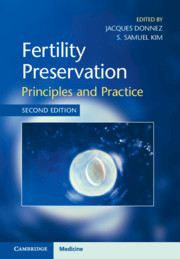Book contents
- Fertility Preservation
- Fertility Preservation
- Copyright page
- Dedication
- Contents
- Contributors
- Foreword
- Foreword
- Preface
- Section 1 Introduction
- Section 2 Reproductive Biology and Cryobiology
- Section 3 Fertility Preservation in Cancer and Non-Cancer Patients
- Section 4 Fertility Preservation Strategies in the Male
- Section 5 Fertility Preservation Strategies in the Female: Medical/Surgical
- Section 6 Fertility Preservation Strategies in the Female: ART
- Chapter 19 Embryo Cryopreservation as a Fertility Preservation Strategy
- Chapter 20 Vitrification of Human Oocytes as a Fertility Preservation Strategy
- Chapter 21 ART and Oocyte Donation in Cancer Survivors
- Section 7 Ovarian Cryopreservation and Transplantation
- Section 8 In Vitro Follicle Culture
- Section 9 New Research and Technologies
- Section 10 Ethical, Legal, and Religious Issues
- Index
- References
Chapter 21 - ART and Oocyte Donation in Cancer Survivors
from Section 6 - Fertility Preservation Strategies in the Female: ART
Published online by Cambridge University Press: 27 March 2021
- Fertility Preservation
- Fertility Preservation
- Copyright page
- Dedication
- Contents
- Contributors
- Foreword
- Foreword
- Preface
- Section 1 Introduction
- Section 2 Reproductive Biology and Cryobiology
- Section 3 Fertility Preservation in Cancer and Non-Cancer Patients
- Section 4 Fertility Preservation Strategies in the Male
- Section 5 Fertility Preservation Strategies in the Female: Medical/Surgical
- Section 6 Fertility Preservation Strategies in the Female: ART
- Chapter 19 Embryo Cryopreservation as a Fertility Preservation Strategy
- Chapter 20 Vitrification of Human Oocytes as a Fertility Preservation Strategy
- Chapter 21 ART and Oocyte Donation in Cancer Survivors
- Section 7 Ovarian Cryopreservation and Transplantation
- Section 8 In Vitro Follicle Culture
- Section 9 New Research and Technologies
- Section 10 Ethical, Legal, and Religious Issues
- Index
- References
Summary
Every year many women worldwide are diagnosed with cancer. More than 90% of cancer patients undergo invasive cancer therapy, such as chemo- and radiotherapy [1]. Most chemotherapy regimens include the alkylating agent cyclophosphamide, which is known to cause a significant loss in ovarian follicle reserve, and may result in infertility and early menopause. The irreversible destruction of germ cells after using both radio and chemotherapy is due to a direct apoptotic effect on oocytes [2]. On the other hand, advances in oncological treatments and better screening programs have significantly improved the life expectancy thus increasing the population of young cancer survivors. Therefore, protection against iatrogenic infertility caused by cancer therapies is considered indispensable to allow patients to have a chance to conceive in the future and to have their own genetic offspring.
- Type
- Chapter
- Information
- Fertility PreservationPrinciples and Practice, pp. 225 - 242Publisher: Cambridge University PressPrint publication year: 2021
References
- 1
- Cited by

